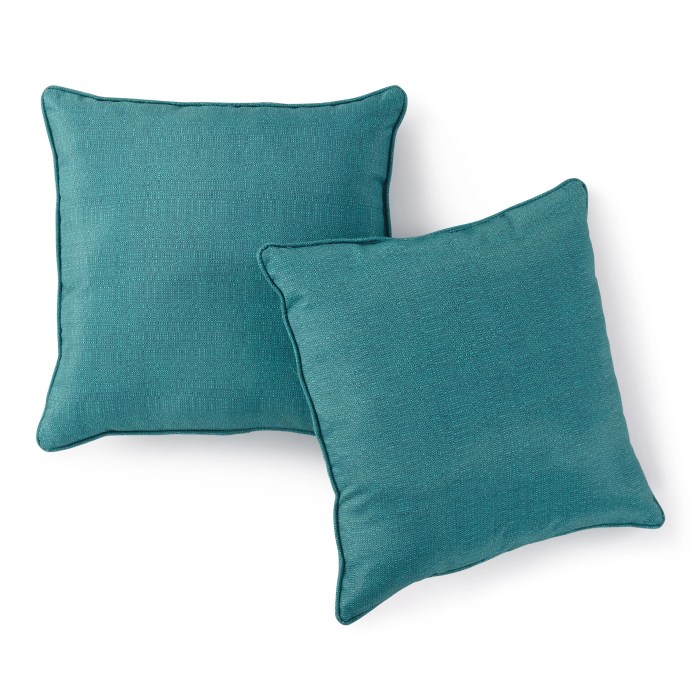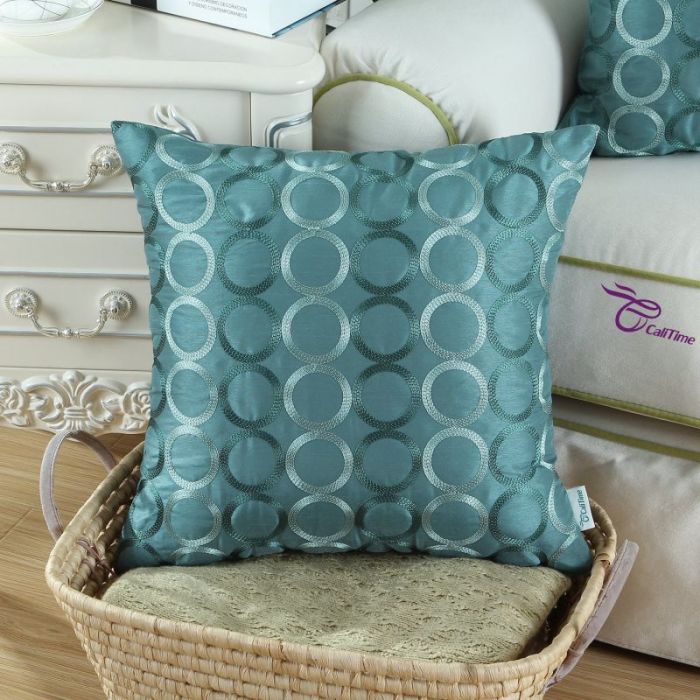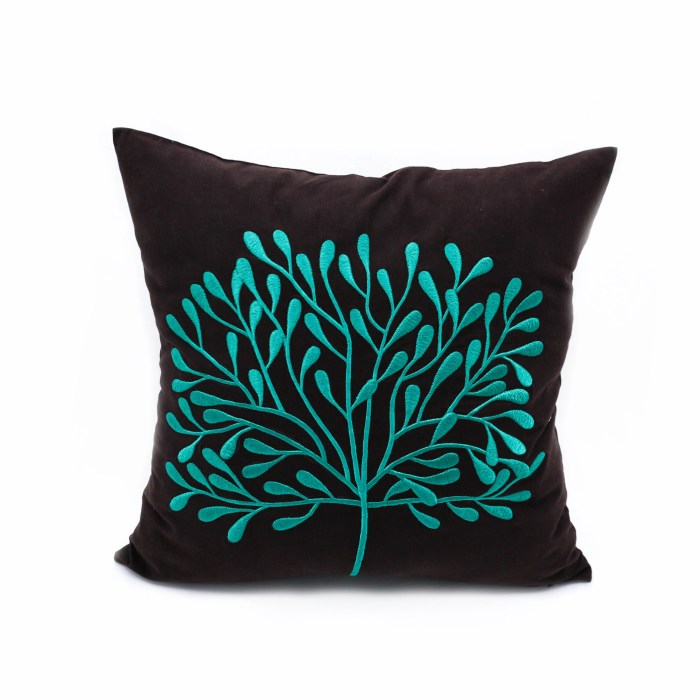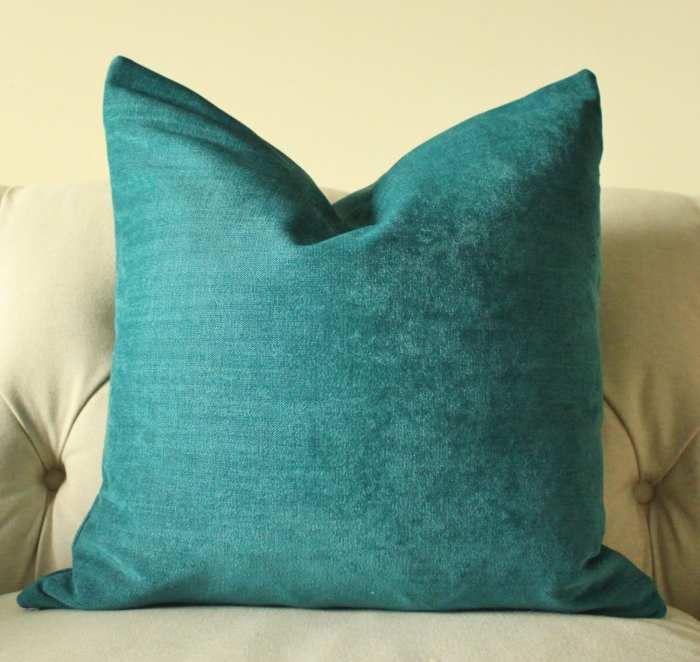Teal decorative pillows: These aren’t just cushions; they’re vibrant accents that can transform a room’s ambiance. From understanding market trends and design aesthetics to mastering the manufacturing process and crafting compelling marketing campaigns, this comprehensive guide dives deep into the world of teal decorative pillows. We’ll explore everything from the ideal customer experience to tackling common challenges in this niche market.
Prepare to unlock the secrets to success in the captivating world of teal home decor.
This guide offers a holistic view, covering market research, design concepts, manufacturing processes, marketing strategies, and customer experience considerations. We’ll analyze color palettes, fabric choices, and sustainable production methods. We’ll also examine effective branding and sales strategies to help you maximize your potential in this competitive market. By the end, you’ll have a complete understanding of the journey from concept to customer satisfaction, and everything in between.
Market Research

The decorative pillow market is a dynamic and competitive landscape, constantly evolving with changing interior design trends and consumer preferences. Teal, a versatile and sophisticated color, holds a significant, albeit nuanced, position within this market. Understanding current trends, target demographics, pricing strategies, and retail channels is crucial for success in this niche.
Current Market Trends for Teal Decorative Pillows
Teal’s popularity in home décor fluctuates, influenced by broader color trend cycles. Currently, various shades of teal, from deep jewel tones to lighter aqua variations, maintain a consistent presence, often integrated into eclectic, bohemian, coastal, and even minimalist interior styles. The demand is driven by consumers seeking to inject calming, sophisticated, or refreshing elements into their living spaces. This demand is further amplified by the rise of online interior design inspiration platforms and social media, where teal’s versatility is showcased across diverse design aesthetics.
Trends suggest a move towards sustainable and ethically sourced materials, impacting the production and marketing of teal decorative pillows. For example, the increasing popularity of organic cotton and recycled materials directly influences the availability and pricing of these pillows.
Primary Demographics of Teal Decorative Pillow Purchasers
While teal’s appeal is broad, certain demographics show a stronger preference. Millennials and Gen Z, known for their interest in eclectic styles and online shopping, represent a significant portion of the market. Homeowners in urban areas, particularly those with smaller spaces, are drawn to teal’s ability to create a sense of calm and sophistication without overwhelming the room.
Furthermore, individuals with a preference for coastal or bohemian décor themes are particularly likely to purchase teal decorative pillows. Affluent homeowners may opt for higher-end, artisan-crafted teal pillows, while budget-conscious consumers may gravitate towards more affordable options. The purchasing decisions are also influenced by lifestyle factors, such as a preference for relaxation and a focus on creating a tranquil home environment.
Pricing Strategies of Teal Decorative Pillow Brands
Pricing strategies vary significantly across brands, reflecting differences in production costs, materials, and brand positioning. Luxury brands often utilize premium materials like silk or velvet and intricate embroidery, resulting in higher price points, sometimes exceeding $100 per pillow. Mid-range brands offer a balance between quality and affordability, using materials like cotton or linen and simpler designs, typically pricing pillows between $20 and $75.
Budget-friendly brands prioritize affordability, using synthetic materials and simpler designs, with prices often below $20. Some brands leverage value-based pricing strategies, offering larger sets or bundles at a discounted rate, while others utilize promotional pricing and discounts to stimulate sales. For instance, brands like Pottery Barn might position themselves in the mid-to-high range, while Target would fall into the budget-friendly category.
Retail Channels for Teal Decorative Pillows
Teal decorative pillows are sold through a variety of retail channels, reflecting the evolving consumer preferences and shopping habits. Online marketplaces like Amazon and Etsy provide access to a vast selection of brands and styles, often offering competitive pricing and convenience. E-commerce websites of individual brands offer curated collections and brand-specific experiences. Brick-and-mortar stores, including home goods retailers, department stores, and specialty boutiques, provide the opportunity for tactile interaction with the pillows and personalized assistance from sales staff.
Furthermore, smaller, independent retailers and artisan shops often feature unique, handcrafted teal pillows catering to a more niche market. The increasing popularity of social media marketing and influencer collaborations drives traffic to both online and offline retail channels.
Design & Aesthetics

Teal, with its captivating blend of blue and green, offers a versatile base for decorative pillow designs. Its inherent coolness allows for a wide range of stylistic interpretations, from calming coastal themes to sophisticated modern aesthetics. The choice of fabric, pattern, and complementary colors significantly impacts the overall mood and visual appeal of the pillow.
Teal Decorative Pillow Design Concepts
Three distinct design concepts can effectively showcase the versatility of teal in decorative pillows. The first emphasizes a minimalist, modern approach; the second focuses on a bohemian, eclectic style; and the third presents a luxurious, traditional aesthetic. Each concept incorporates different textures and embellishments to enhance the visual impact.
- Concept 1: Modern Minimalism. A simple, rectangular pillow in a deep teal linen fabric. The linen’s natural texture adds a subtle sophistication. Minimalist embellishment could include a single, subtly contrasting embroidered line along one edge, perhaps in a soft silver or cream color.
- Concept 2: Bohemian Eclecticism. A square pillow featuring a vibrant teal cotton fabric with a geometric print in shades of gold and ivory. Fringe detailing along the edges adds a bohemian touch, and small, decorative tassels in coordinating colors could be incorporated. The cotton provides a comfortable, breathable feel.
- Concept 3: Luxurious Tradition. A plush, round pillow crafted from a rich teal velvet. The velvet’s deep pile adds a luxurious feel and a sophisticated sheen. Embellishment could include subtle beading or embroidery in a complementary jewel tone, such as emerald green or sapphire blue, arranged in a classic floral pattern.
Color Palettes Complementing Teal
The color palette chosen to complement teal significantly impacts the overall design. Harmonious combinations emphasize a cohesive and calming effect, while contrasting palettes create a more dramatic and visually striking result.
- Harmonious Combinations: Pairing teal with shades of beige, cream, or ivory creates a serene and sophisticated atmosphere. Adding accents of muted gold or silver can elevate the elegance. Think of a coastal-inspired room with cream walls, teal pillows, and subtle gold accents.
- Contrasting Combinations: For a bolder look, teal can be paired with contrasting colors like coral, mustard yellow, or burnt orange. These vibrant hues create a visually exciting juxtaposition, ideal for a more eclectic or bohemian style. Imagine a vibrant living room with mustard yellow walls, teal pillows, and pops of coral in the artwork.
Comparison of Teal Shades for Pillows
Different shades of teal offer distinct visual effects. The choice depends on the desired mood and overall aesthetic.
| Teal Shade | Description | Best Suited For | Overall Impression |
|---|---|---|---|
| Turquoise | Brighter, more green-leaning teal. | Coastal, summery, playful designs. | Fresh, vibrant, energetic. |
| Teal Blue | Deeper, more blue-leaning teal. | Sophisticated, modern, calming designs. | Serene, elegant, sophisticated. |
| Seafoam | Lighter, more muted teal. | Relaxing, beachy, minimalist designs. | Calm, airy, understated. |
Impact of Fabric Choice on Teal Pillows
The fabric selected significantly impacts the overall look and feel of a teal decorative pillow. Different fabrics offer varying textures, levels of formality, and durability.
- Velvet: Adds a luxurious, rich feel. Ideal for creating a sophisticated and opulent atmosphere. The deep pile enhances the color’s depth and vibrancy.
- Linen: Offers a natural, relaxed aesthetic. Its slightly textured surface adds a subtle visual interest, suitable for minimalist or bohemian styles.
- Cotton: Provides a comfortable, breathable option. Suitable for a variety of styles, from casual to slightly more formal, depending on the print or embellishment.
Marketing & Sales

Successfully marketing teal decorative pillows requires a multi-pronged approach targeting diverse consumer segments with tailored messaging and visuals. This section Artikels three distinct marketing campaign concepts, corresponding marketing materials, successful branding examples, and potential partnerships to maximize sales.
Marketing Campaign Concepts
Three distinct marketing campaigns can effectively target different consumer demographics interested in teal decorative pillows. Each campaign will leverage unique messaging and visual styles to resonate with its specific audience.
- Campaign 1: “Serene Sanctuary” (Target: Millennials and Gen Z seeking minimalist aesthetics): This campaign focuses on the calming and sophisticated aspects of teal, associating it with mindful living and creating a tranquil home environment. Marketing materials will feature clean, minimalist photography showcasing the pillows in modern, sparsely decorated spaces. The color palette will be muted, emphasizing the teal’s subtle elegance.
- Campaign 2: “Coastal Chic” (Target: Homeowners with coastal or nautical-themed decor): This campaign highlights teal’s association with the ocean and seaside living. Marketing materials will feature bright, airy photography showcasing the pillows in beach houses or rooms with nautical accents. The color palette will be vibrant, incorporating whites, blues, and sandy tones alongside the teal.
- Campaign 3: “Bold & Luxurious” (Target: Affluent homeowners seeking high-end home decor): This campaign emphasizes the richness and luxurious feel of a deep teal. Marketing materials will feature high-quality photography showcasing the pillows in opulent settings, such as elegant living rooms or master bedrooms. The color palette will be rich and sophisticated, using deep teal as a statement color alongside gold accents and plush textures.
Marketing Materials
Effective marketing materials are crucial for showcasing the unique features of teal decorative pillows. These materials should be visually appealing and clearly communicate the value proposition of each campaign.
- Social Media Posts: Each campaign will utilize platform-specific content. Instagram will feature high-quality lifestyle photography and short videos showcasing the pillows in various settings. Facebook will utilize carousel ads showcasing different pillow designs and color variations. TikTok will leverage trending audio and short, engaging videos demonstrating the pillows’ comfort and versatility.
- Website Banners: Website banners will feature eye-catching visuals that align with each campaign’s aesthetic. The “Serene Sanctuary” banner will use a minimalist design with soft lighting and a calming color palette. The “Coastal Chic” banner will feature a brighter, more playful design with nautical elements. The “Bold & Luxurious” banner will utilize a sophisticated design with rich textures and luxurious details.
- Copywriting: Copywriting will be tailored to each campaign’s target audience. The “Serene Sanctuary” copy will emphasize relaxation and tranquility. The “Coastal Chic” copy will highlight the pillows’ ability to create a beachy atmosphere. The “Bold & Luxurious” copy will emphasize the pillows’ quality and high-end design.
Branding Strategies of Successful Companies
Several successful home decor companies employ effective branding strategies that can be adapted for teal decorative pillows. West Elm, for example, effectively utilizes a modern, minimalist aesthetic with high-quality photography to showcase its products. Pottery Barn, on the other hand, focuses on creating a sense of luxury and comfort through rich visuals and storytelling. Analyzing and adapting these strategies can enhance brand recognition and consumer appeal.
Potential Partnerships and Collaborations
Strategic partnerships can significantly boost sales. Collaborations with interior designers, home staging companies, and lifestyle bloggers can increase brand visibility and reach a wider audience. Furthermore, partnerships with complementary businesses, such as furniture stores or home fragrance companies, can create synergistic marketing opportunities. For instance, a collaboration with a local interior design firm could feature the pillows in model homes or design showcases.
Customer Experience: Teal Decorative Pillows

A positive customer experience is paramount for the success of teal decorative pillows. It encompasses every interaction a customer has with the product, from initial browsing to post-purchase satisfaction. This includes the ease of purchase, the quality of the product itself, and the resolution of any potential issues. A seamless and enjoyable experience fosters customer loyalty and positive word-of-mouth marketing.The ideal customer experience begins with a user-friendly website showcasing high-quality images and detailed product descriptions of the teal decorative pillows.
Easy navigation, clear pricing, and secure checkout processes are crucial. Upon receiving the pillows, customers should find them beautifully packaged and exceeding their expectations in terms of quality, texture, and color accuracy. The pillows should be comfortable and durable, providing long-lasting aesthetic appeal and functionality. Post-purchase, excellent customer service ensures quick resolution of any concerns, fostering trust and brand loyalty.
Potential Customer Pain Points and Solutions, Teal Decorative Pillows
Several potential issues can negatively impact the customer experience. For example, inaccurate color representation online can lead to disappointment upon delivery. Solutions include using professional photography with color calibration and providing detailed descriptions, including fabric type and texture, to manage expectations. Another pain point might be slow shipping or damaged goods. Addressing this requires partnering with reliable shipping providers and implementing robust packaging to protect the pillows during transit.
Finally, unclear return policies can create friction. A transparent and easy-to-understand return policy, alongside a hassle-free return process, will significantly improve customer satisfaction.
Impact of Positive Online Reviews and Testimonials
Positive online reviews and testimonials are invaluable for driving sales. They act as social proof, building trust and credibility with potential customers. Reviews highlighting the beauty, quality, and comfort of the teal decorative pillows, alongside positive comments on customer service, can significantly influence purchase decisions. For example, a review stating, “These pillows are even more stunning in person! The teal color is rich and vibrant, and the fabric is incredibly soft.
Customer service was also excellent – I received a prompt response to my inquiry,” can persuade others to make a purchase. Actively encouraging customers to leave reviews and showcasing positive testimonials prominently on the website and social media platforms can boost sales effectively.
Handling Customer Complaints and Negative Feedback
Addressing customer complaints and negative feedback promptly and professionally is vital. Ignoring negative feedback can damage brand reputation and deter potential customers. A proactive approach involves actively monitoring online reviews and social media mentions. When a complaint arises, responding empathetically and offering a solution, such as a refund, replacement, or discount, is crucial. Publicly addressing negative feedback on platforms like review sites demonstrates transparency and commitment to customer satisfaction.
For instance, a response like, “We sincerely apologize for the inconvenience you experienced. We’ve investigated the issue and have taken steps to prevent it from happening again. We’d like to offer you a full refund or a replacement pillow.” shows that the company values customer feedback and takes responsibility for resolving issues. This approach can transform a negative experience into a positive one, potentially turning a dissatisfied customer into a loyal advocate.
Creating and selling successful teal decorative pillows requires a multifaceted approach. From understanding market demand and designing visually appealing products to implementing effective marketing strategies and providing exceptional customer service, each element plays a crucial role in achieving success. By carefully considering the design, production, and marketing aspects, businesses can create a thriving niche within the home decor market.
Remember, understanding your customer and providing a high-quality product are key to long-term success in this vibrant field. The possibilities are as endless as the shades of teal itself.